
Cabaret Voltaire was the name of a short-lived nightclub in Zürich, Switzerland, in 1916, revived in the 21st century. It was founded by Hugo Ball, with his companion Emmy Hennings, in the back room of Holländische Meierei, Spiegelgasse 1, on February 5, 1916, as a cabaret intended for artistic and political purposes. Other founding members were Marcel Janco, Richard Huelsenbeck, Tristan Tzara, Sophie Taeuber-Arp and Jean Arp.
Benno Ohnesorg was a West German university student killed by a policeman during a demonstration in West Berlin. His death spurred the growth of the left-wing German student movement.

The Kunsthaus Tacheles was an art center in Berlin, Germany, a large building and sculpture park on Oranienburger Straße, in the sub-neighborhood of Spandauer Vorstadt in the Mitte district. Huge, colorful graffiti-style murals were painted on the exterior walls, and modern art sculptures were featured inside. The building housed an artist collective from 1990 until 2012.
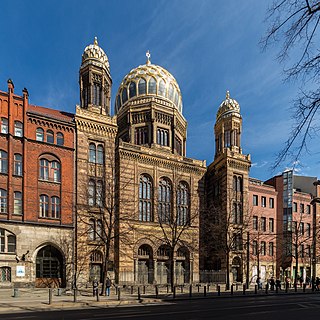
The New Synagogue on Oranienburger Straße in Berlin is a mid-19th century synagogue built as the main place of worship for the city's Jewish community, succeeding the Old Synagogue which the community outgrew. Because of its Moorish style and resemblance to the Alhambra, the New Synagogue is an important architectural monument in Germany.

Nollendorfplatz is a square in the central Schöneberg district of Berlin, Germany.
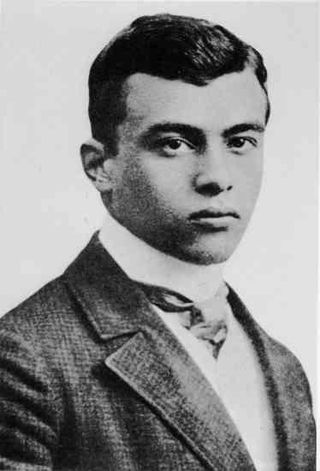
Jakob van Hoddis was the pen name of the Jewish German expressionist poet Hans Davidsohn, of which "Van Hoddis" is an anagram. His most famous poem Weltende, published on 11 January 1911 in the Der Demokrat magazine, is generally regarded as ushering in the Expressionist style of poetry and inspired many other poets to write in a similarly grotesque style; he is also seen as perhaps the only German predecessor of surrealism.

Alexander (Alex) Beer was a German architect.

The German Resistance Memorial Center is a memorial and museum in Berlin, capital of Germany.
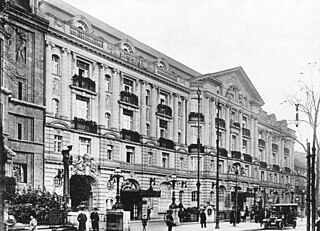
Hotel Esplanade was a luxury hotel with 400 rooms, which once stood on Berlin's busy transport and nightlife hub Potsdamer Platz. During its colorful and turbulent history it went from being one of the German capital's most luxurious and celebrated hotels to a bombed-out ruin lost in the wastelands alongside the Berlin Wall. A section of it still survives today, albeit as a fragment incorporated into the soaring modern complex of the Sony Center. Wilhelm II is said to have spent many evenings at the hotel entertaining guests, although no women were allowed at these dining parties. The hotel was visited in the 1920s by movie stars such as Charlie Chaplin and Greta Garbo.

Hackescher Markt is a square in the central Mitte locality of Berlin, Germany, situated at the eastern end of Oranienburger Strasse. It is an important transport hub and a starting point for the city's nightlife.
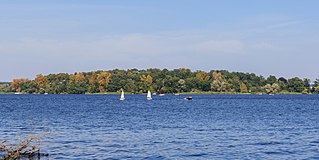
Schwanenwerder is an island in the locality of Nikolassee in southwestern Berlin, located in a wider stretch of the Havel close to the eastern bank and adjacent to the Großer Wannsee to the south of it. The neighbourhood is considered an affluent residential area and was home to known people such as Alexander Parvus, Joseph Goebbels, Gustav Fröhlich, Ernst Udet, Axel Springer, and Lída Baarová.

The Shopping mall Fünf Höfe in the center of Munich was created from 1998 to 2003 after the coring of a HypoVereinsbank building complex. In 2004, the Fünf Höfe was sold to DIFA and since then the official name has been CityQuartier Fünf Höfe.

Berlin is recognized as a world city of culture and creative industries. Numerous cultural institutions, many of which enjoy international reputation are representing the diverse heritage of the city. Many young people, cultural entrepreneurs and international artists continue to settle in the city. Berlin has established itself as a popular nightlife and entertainment center in Europe.

The Café des Westens, on No.18/19 Kurfürstendamm in Berlin, was a coffeehouse which operated from 1898 to 1915, and became famous as a meeting place for turn of the century artists. It was known colloquially as Café Größenwahn; the German Größenwahn meaning "delusions of grandeur".

The following is a compilation of memorials to the composer Frédéric Chopin in the form of physical monuments, institutions, and other entities named after him.

Der Neue Club was an Expressionist club founded in the Hackesche Höfe courtyards, Berlin by Kurt Hiller and Jakob van Hoddis.

Berlin memorial plaque is a special form of commemorative plaque, made by the Royal Porcelain Factory, in Berlin that was introduced in 1985 in preparation for the city's 750th anniversary in 1987. The porcelain-coloured panels have a rectangular shape measuring 60 by 40 centimetres and bear the title "Berlin Memorial Plaque" in capital letters and a cobalt blue explanatory inscription on a white background. The factory logo is present at the base of the panel, in the form of a cobalt blue sceptre. The design was determined in a competition that was won by the graphic artist Wieland Schütz.
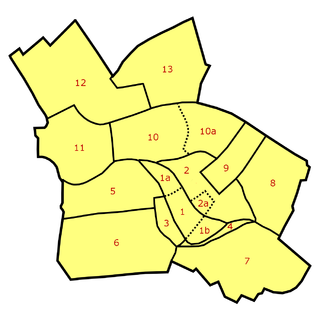
Spandauer Vorstadt is a historic district in what is now the Mitte district of Berlin.

The Memorial to the First Homosexual Emancipation Movement is a memorial in the neighbourhood of Moabit in Berlin, Germany. Unveiled on 7 September 2017, the memorial is located opposite the Federal Chancellery on the Spree and commemorates the first homosexual movement, which was destroyed in 1933 by the Nazis, and especially the Scientific-Humanitarian Committee founded in 1897 to oppose the criminalization of homosexuality in Germany. The Scientific-Humanitarian Committee's headquarters were located on the other bank of the Spree near the Federal Chancellery. The riverbank where the memorial is located has been named the Magnus-Hirschfeld-Ufer since 2008. The memorial includes an information panel that has been in place since 2011 and discusses the movement with portraits of Anita Augspurg (1857–1943), Karl Heinrich Ulrichs (1825–1895) and Magnus Hirschfeld (1868–1935).























